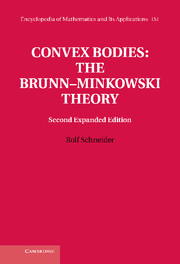Book contents
- Frontmatter
- Contents
- Preface to the second edition
- Preface to the first edition
- General hints to the literature
- Conventions and notation
- 1 Basic convexity
- 2 Boundary structure
- 3 Minkowski addition
- 4 Support measures and intrinsic volumes
- 5 Mixed volumes and related concepts
- 6 Valuations on convex bodies
- 7 Inequalities for mixed volumes
- 8 Determination by area measures andcurvatures
- 9 Extensions and analogues of theBrunn–Minkowski theory
- 10 Affine constructions and inequalities
- Appendix Spherical harmonics
- References
- Notation index
- Author index
- Subject index
2 - Boundary structure
Published online by Cambridge University Press: 05 December 2013
- Frontmatter
- Contents
- Preface to the second edition
- Preface to the first edition
- General hints to the literature
- Conventions and notation
- 1 Basic convexity
- 2 Boundary structure
- 3 Minkowski addition
- 4 Support measures and intrinsic volumes
- 5 Mixed volumes and related concepts
- 6 Valuations on convex bodies
- 7 Inequalities for mixed volumes
- 8 Determination by area measures andcurvatures
- 9 Extensions and analogues of theBrunn–Minkowski theory
- 10 Affine constructions and inequalities
- Appendix Spherical harmonics
- References
- Notation index
- Author index
- Subject index
Summary
Facial structure
The notions of face, extreme point and exposed point of a convex set were defined in Section 1.4. In the present section we shall study the boundary structure of closed convex sets in relation to these and similar or more specialized notions. We shall assume in the following that K ⊂ ℝn is a nonempty closed convex set.
An i-dimensional face of K is referred to as an i-face. By F(K) we denote the set of all faces and by Fi(K) the setofall i-faces of K. A face of dimension dim K – 1 is usually called a facet. The empty set ∅ and K itself are faces of K; the other faces are called proper. Conventionally, the empty face has dimension –1. It follows from the definition of a face and from Lemma 1.1.9 that the faces of K are closed. If F ≠ K is a face of K, then F ∩ relint K = ∅. (If z ∈ F ∩ relint K, we choose y ∈ K \ F. There is some x ∈ K with z ∈ relint [x,y]. Then [x,y] ⊂ F, a contradiction.) In particular, F ⊂ relbd K and dim F < dim K.
- Type
- Chapter
- Information
- Convex Bodies: The Brunn–Minkowski Theory , pp. 74 - 138Publisher: Cambridge University PressPrint publication year: 2013
- 1
- Cited by

